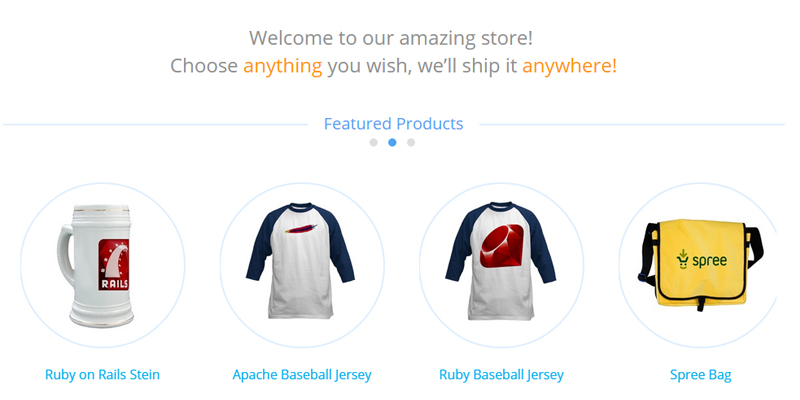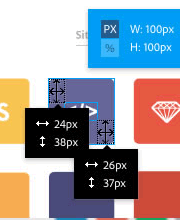Having looked at 10 of the best online ecommerce solutions, let’s now explore their self-hosted counterparts. In compiling this list I have considered product quality, features, community support, usage (through BuiltWith.com) and general popularity.
I have considered ecommerce tools for both small businesses and larger companies and have provided an example for each. All of the tools are free so you are welcome and encouraged to try them out for yourself.
1. Magento
Let’s start with the undisputed leader in ecommerce platforms – Magento. Released in May 2014, Magento Community Edition 1.9 is becoming increasingly popular and the community is eagerly awaiting Magento 2.0. Since eBay Inc. acquired Magento in 2011 development has severely slowed down, but no other solution can boast its current market share of 11%.
Benefits
When paired with a high-quality theme Magento can help you build the web store of your dreams. Hours can be spent simply configuring how your want your product listings to look (in a good way). Different store fronts with one shared product base can be set up with ease, professional landing pages are simple to build and you are able to connect almost any tool or service out there. Few ecommerce tools come close to matching Magento, at least not without installing a whole host of plugins.
Noteworthy features
- Features! There are plenty of features and product attributes to use. To see for yourself you can take a look at my Magento vs. X-Cart screencast from the eight minute mark.
- Hundreds of professional and high-quality templates available.
- No need to upgrade to a better solution in the future, Magento is scalable beyond your imagination.
Magento is a resource beast. It will soon outgrow shared hosting and it has a whole set of hosting requirements (like recommending that you host your backend on a separate server).
I have covered Magento before in a comparison with WooCommerce and as mentioned above with X-Cart in a screencast.
Magento (Community Edition) can be downloaded for free at Magento.com.
2. WooCommerce
According to BuiltWith, WooCommerce is just behind Magento running a whopping 7.4% of all ecommerce stores measured. That’s pretty impressive considering that WooCommerce is only three years old. What helps is that it runs on WordPress, and it only takes a few minutes to become familiar with.
WooCommerce is one of my personal favorites and I have already written quite a number of articles about it previously for SitePoint.
Benefits
WooCommerce is a pretty light application and doesn’t put a strain on your server resources like Magento does. Its basic functionality is above average, with hundreds of high quality plugins available to enhance it further.
If you’re already familiar with WordPress then learning WooCommerce is a breeze, as it incorporates WordPress’s best practice usability. You can use widgets in the way that you’re used to and if you use WooCommerce optimized themes both your regular site and WooCommerce store will have the same look and feel.
Noteworthy features
- Makes use of most free and paid WordPress plugins.
- Easy set up and configuration.
- Hundreds of beautiful themes available at reasonable prices.
WooCommerce can be downloaded for free at WooThemes.com.
3. Zen Cart
Example: Rose City Vintage
Originally a spin-off from osCommerce, Zen Cart is one of the oldest carts in this list, yet it still has a 3% usage count, however that is declining. You will find hundreds of Zen Cart-specialized programmers on various freelance sites, who love Zen Cart for its PHP/MySQL based foundation.
Benefits
While not the prettiest face, Zen Cart certainly has one of the more friendly souls. Take a look at the source code of the demo store and compare it to other carts – its features are on par with most of the others, but Zen Cart is largely focussed on support.
One of the reasons Zen Cart is still popular is that it allows non-programmers to adjust some settings in the code if needed. It also has hundreds of well-developed plugins along with one of the most active forums you’ll find. Zen Cart’s documentation is highly detailed – it even has an extensive wiki.
Noteworthy features
- Documentation: forums, wiki, guides, you name it!
- Almost 2,000 professional plugins available, most of them free.
- Newbie-friendly code base.
Zen Cart is open source and can be downloaded for free at Zen-Cart.com.
4. osCommerce
Example: osMart Theme
The next most popular ecommerce solution by usage is osCommerce. To me osCommerce is a trip down memory lane as I used it to build my first web store.
The usage of osCommerce is pretty steady, with occassional upward spikes. As with Zen Cart, it’s easy to use and you can find many low-priced programmers to work on your store. You will find osCommerce in the recommendation lists of many of large hosting companies.
Benefits
osCommerce has a simple interface with which you will quickly become acquainted. Its settings are reasonably detailed, but in building web stores for your customers, the usability of the catalog management is a big plus.
osCommerce has an even larger support base than Zen Cart, with over 1.5 million forum posts in their community. With 7,000 plugins in the repository and many more available on developers’ pages outside of the official site, you’ll rarely be without functionality. Building your own plugin is reasonably simple if you have some experience, or alternatively you can hire skilled programmers for under $10 per hour.
osCommerce has all the basic features needed, but the real power lies in the thousands of available plugins to extend its functionality. I have included a professional theme as example above as the official osCommerce demo makes me want to cry.
Noteworthy features
- Warm and friendly helpers among their 280,000 (!) forum members and many localized support sites.
- Almost unlimited expandability with 7,000 plugins.
- Speed – osCommerce stores are incredibly light weight.
osCommerce can be downloaded for free at osCommerce.com.
5. OpenCart
OpenCart is currently still behind Zen Cart and osCommerce in usage figures, but is steadily rising. It even has the potential to surpass these two when OpenCart 2.0 is released. OpenCart has one of the cleanest storefront designs of all default themes.
Benefits
I have discussed OpenCart before, comparing it to PrestaShop in a Prezi for SitePoint.
OpenCart is easy to work with and provides the ability to edit CSS from within the admin, which makes it easier to quickly change the layout. OpenCart also has many integrated payment and shipping options.
There are hundreds of professional templates available, however there are very few free themes. OpenCart has a vast number of plugins available at 13,000 – most of them paid. On offer is an extensive partner network who will provide paid support should you not want to use the community forums, which aren’t as sizeable as osCommerce or Zen Cart’s.
Noteworthy features
- 13,000 professional plugins available.
- Enough built-in integration to get you started immediately.
- Active development, with OpenCart 2.0 due to be released soon.
OpenCart can be downloaded for free at OpenCart.com.
6. PrestaShop
PrestaShop is the currently the last ecommerce tool in the BuiltWith ecommerce list by usage, but is on the way up. I have compared PrestaShop to OpenCart in the past and I still find it an intriguing tool.
Benefits
PrestaShop is run by a commercial company, which is focused on competing at the top. Their built-in feature set is already impressive, covering all necessary sales tools like cross selling, coupons, etc. They also have many high-quality yet low priced or free plugins along with reasonably priced professional themes.
The way that PrestaShop market and support their product is impressive. There are about ten localized websites, even one for my own small country – the Netherlands. Many plugin descriptions are translated well across multiple languages, they provide a popular forum and offer very extensive documentation.
PrestaShop works closely with partners and do their best to refer clients. Given their excellent product and dedication I won’t be surprised if they would soon begin to climb this list.
Noteworthy features
- Feature set comparable to Magento.
- Extensive documentation and support options, including reasonably priced paid support.
- A plethora of free or low priced plugins and themes of excellent quality.
PrestaShop can be downloaded for free at PrestaShop.com.
7. X-Cart
X-Cart isn’t on the BuiltWith list yet but it certainly has the potential to get there. I have discussed X-Cart before (vs. Magento) and I also had a look at their online version in a round-up of the most popular online ecommerce solutions. X-Cart is famous for their rapid development cycle and care for developers. X-Cart recently changed its pricing structure – which now even offers a free license.
Benefits
X-Cart ensured a heavy focus on mobile throughout its growth – they were one of the first companies to have a professional responsive base template. Their feature set is rich and paired with a simple admin system. You can download additional modules from X-Cart for free or at low cost, as well as extensions made by independent developers.
X-Cart loves to work alongside developers using their products. As a developer you will receive extensive documentation, such as design guides for creating templates. There is an active community to assist, along with paid support (which can be a bit pricey). There is even the option to earn money when you sign up as a template designer or extension developer, which is actively encouraged. You won’t be left in the dark when developing with X-Cart.
Noteworthy features
- Extensive documentation and support options.
- More than enough features in free products and free modules.
- X-Cart gives a new meaning to being developer friendly.
X-Cart recently changed their pricing, which turned their $99 license into a free one. As this license also comes with dozens of popular modules for free it really is a great offering.
X-Cart can be downloaded for free at X-Cart.com.
8. SpreeCommerce
Example: Limited Time Demo
Spree Commerce is not the most familiar name in this list, yet it currently powers large online retailers like Bonobos.com. While end users can download and use Spree, it’s more aimed at developers using it as a framework for a new web store. There is no public demo, but you can set up one for yourself and look inside the admin.
Benefits
Spree Commerce is not something you learn within a few minutes. They offer some advanced filtering options, but use very confusing terminology to do so. A category is called a taxonomy and a sub-category is a taxon. But there are also tax categories, which have nothing to do with navigation.
Tax categories are a perfect example of how detailed Spree can be – you are able create various tax groups based on your items. Another example of Spree’s detail is the ability to set up stock locations, an indication of Spree’s intended use for larger web stores.
Spree Commerce isn’t something you would use when you’re first starting out. It’s a very advanced platform in line with the enterprise features Magento can give you. While it’s not a popular platform yet, current developers using Spree are absolutely loving it which is a great indication of its potential.
Noteworthy features
- Suitable for larger web stores.
- Built with Ruby on Rails.
- Professional feature set with large companies in mind.
Spree Commerce can be downloaded for free at SpreeCommerce.com.
9. VirtueMart
Example: VirtueMart Demo
VirtueMart is the Joomla! counterpart of WooCommerce and Drupal Commerce. While they have one of the craziest home pages I’ve seen, there is a separate website dedicated to developers.
Benefits
VirtueMart can certainly compete with PrestaShop on features. Unlike Drupal Commerce, VirtueMart is more of a product on its own, instead of just a Joomla! extension. Advanced features such as a discount calculator with dozens of price rules and a rating system are built-in. There are hundreds of extensions available, although most of these are paid.
As I mentioned there is a fully dedicated developer website, maintained by a large group of developers. There is also a very detailed documentation website and a community forum with almost 300,000 posts. Remember that this is for VirtueMart alone – pretty impressive.
If you want to stick to Joomla! then VirtueMart is an excellent choice.
Noteworthy features
- Built on Joomla! which provides an easy learning curve for those already familiar with Joomla!.
- Professional and advanced feature set.
- Great support and documentation.
VirtueMart can be downloaded for free at VirtueMart.net.
10. Drupal Commerce
Example: CommerceGuys Demo
Drupal Commerce is to Drupal what WooCommerce is to WordPress. It’s an extremely popular and arguably the best ecommerce plugin for Drupal. Drupal Commerce is built on Drupal 7 and actively developed by an ecommerce consultant and development company (CommerceGuys) in conjunction with volunteering programmers.
Benefits
Drupal Commerce puts its emphasis on keeping it as close to the Drupal architecture as possible. It has all the necessary ecommerce features, but isn’t as fully loaded as WooCommerce. Instead, Drupal Commerce gives you all the flexibility you need to enhance the cart yourself. The volume of documentation available is impressive and they have both a community and Q&A section.
A great way to get started immediately without needing to do much modification is through distributions. “Distributions provide site features and functions for a specific type of site as a single download containing Drupal core, contributed modules, themes, and pre-defined configuration.” Commerce Kickstart is a good example of a distribution and of course you can fine-tune to your heart’s content. All in all Drupal Commerce is a very professional ecommerce extension for Drupal, certainly if that’s your go-to platform for regular websites.
Noteworthy features
- Built on Drupal 7 using best practices.
- Extensive documentation for developers.
- Managed by a company of Drupal experts.
Drupal Commerce can be downloaded for free at DrupalCommerce.org.
Conclusion
Whether you are building a store with only a few products or a large enterprise web store, at least one of the listed self-hosted ecommerce solutions will do the job. You can build on top of WordPress, Drupal, Joomla! or use a stand-alone application. Always keep in mind that switching platforms is a nightmare, so make sure that your decision takes into account your future direction.
Although these are some of the most popular ecommerce solutions around, there are always more. Please feel free to share below what your favorite tool is.
 Jacco Blankenspoor
Jacco BlankenspoorJacco Blankenspoor is a website developer from the Netherlands, and is currently just building lots of different websites. When he is not working on HIPAAHQ.com you might catch him grinding coffee.








